Krawlspace Member Username: Krawlspace Post Number: 318 Registered: 04-2004 |
Hey guys... So I am putting my Detroit Historical Calendar together again, and have a shot of the Huron Building I wanted to include. This building is remarkable in that C. Howard Crane had an office there ca. 1920. The building stood at Congress and Griswold, where the Guardian now sits and was partially used as the Union Trust Company's Annex. My question is weather this was Cranes first office in Detroit? I know he went on his own in 1909, and I have prints for the Macomb Theatre in Mt. Clemens drawn up in 1920 with the Huron Building listed as Cranes US office. I would like to caption the photo as his first office, but I wanted to try to be certain. Thanks for the help! | ||
Aiw Member Username: Aiw Post Number: 6367 Registered: 10-2003 |
K. let me check what I have at home. My information tends to deal more with his time in Windsor, and then his time in England at the end. Technically, his first office was in Windsor  When he was with James Watt. I think he didn't return to the US on his own until 1913-14... When he was with James Watt. I think he didn't return to the US on his own until 1913-14... | ||
Krawlspace Member Username: Krawlspace Post Number: 319 Registered: 04-2004 |
Hey there Aiw... Thanks for the time. The print lists his Canadian Office as 6 Victoria Block, Windsor, Ontario. It also lists Elmer George Kiehler as his associate and a non titled gentleman named Cyril E. Schley. Quick research co-credits the UA and Lafayette buildings to Kiehler, and credits the Rio and Telenews to Schley. | ||
Aiw Member Username: Aiw Post Number: 6368 Registered: 10-2003 |
That I think was a branch office of the US one, and is later... I'll see what I can dig up. | ||
56packman Member Username: 56packman Post Number: 1761 Registered: 12-2005 |
Kiehler was the structural man, the engineer who designed all of the super superstructures for Crane.I know his nephew. Built strong to last long! | ||
Aiw Member Username: Aiw Post Number: 6369 Registered: 10-2003 |
Ok Krawl. What I have isn't lot of help, but it does firm up some dates. From 1905-1909 he worked for both Albert Kahn and Smith, Hinchman & Grylls. In 1909 he came to Windsor and entered a partnership with James Watt. Their only credited structure I have attributed is a church from 1909, near Willistead Park. I'm not sure what kind of arrangement they had, as by 1910, Watt was gone, and the firm was now called Crane and Pennington. (J.C. Pennington was a long time Windsor Architect who was active through the late 50's.) From what I have, Crane and Pennington worked together until Crane returned to Detroit in 1914. While not a ton of help, if you could find a city directory from 1914, you would at leat be able to track down his first US office. From a December 30, 1937 article in the Windsor Star: quote: | ||
Gistok Member Username: Gistok Post Number: 5368 Registered: 08-2004 |
Hmmmm, since the Huron Building had to get rid of its tenants by 1927 at the latest (to start the demo for the 1928-29 construction of the Guardian Building)... probably at some point around 1926-27 (the Michigan Building opened in 1926) he moved his offices to the Michigan Building. I assume he remained there until moving to London England in the early 30's. I asked Michigan Building owner Tony Pieroni if he knew what floor his offices were on, but he didn't. Lisa DiChiera (daughter of David DiChiera of MOT/Detroit Opera House) did a doctorial dissertation on C. Howard Crane. I talked extensively to her mother Karen Vanderkloot DiChiera at the theatre tours. I wanted to find out where C. Howard Cranes offices were in the Michigan Building, and for how long, but she didn't know. I think we would all love to read that dissertation! Even though C. Howard Crane died in 1952 and is buried in London England, his grandson, C. Howard Crane III lives in the Grosse Pointes. I am not aware of branch offices that C. Howard Crane had in other USA cities. C. Howard Crane's tallest building design (and IMHO his best non-theatre commission) was the Leveque-Lincoln Tower in Columbus Ohio (for nearly 40 years the tallest building in that city). Ironically the Palace Theatre in that building was designed by fellow palace architect Thomas Lamb, who was still in his tame Adamesque style of theatre design. Crane's Art Deco office lobby blows the socks off of the very tame theatre design. C. Howard Crane was also involved with the largest movie palace in New England, the 4,400 seat Metropolitan Theatre in Boston (now the Wang Center for the Performing Arts). Architect C.A. Blackall got a lot of help from C. Howard Crane, whose influence can be seen all over that theatre design. Crane may have had a branch office in Boston. P.S. In the movie THE WITCHES OF EASTWICK, the enormous staircase in the house that Jack Nickolson's character shared with the 3 witches was filmed in the Crane influenced grand lobby of the Wang Center. (Message edited by Gistok on September 19, 2007) | ||
Aiw Member Username: Aiw Post Number: 6377 Registered: 10-2003 |
Krawl, once it's done let me know. | ||
Jjaba Member Username: Jjaba Post Number: 5544 Registered: 11-2003 |
Thanks Gistok. Hands down, you are The Theater Expert on this Forum. Thanks to AIW since he's the all-time expert on things Canadian. jjaba, Westsider. | ||
Krawlspace Member Username: Krawlspace Post Number: 320 Registered: 04-2004 |
Thanks for all the help guys... I will take a trip to Burton and try to look up his office ca 1914. I will post here and in the classified ads when it is finished. With luck it should be mid October. I may actually have every date square filled with an historical note this year. Yay! | ||
Gistok Member Username: Gistok Post Number: 5397 Registered: 08-2004 |
Thanks Jjaba! Trust me when it comes to the knowledge of theatres, Krawlspace and 56packman both know a LOT about Detroit area theatres, and 56packman is also very knowledgeable about theatres and theatre organs country wide. AIW thanks for all the info on C. Howard Crane's offices in Canada. I was not aware that he had his office there, but it makes perfect sense... There was a theatre chain across Canada that was known as the Allen Theatres. They built something like 23 theatres, and C. Howard Crane was their principal architect (now it makes sense for his offices in Canada). By 1921 Allen was planning theatres in Cleveland and Detroit. The 3009 seat Allen Theatre (Crane design) opened in 1921 on Euclid Ave. in Cleveland's Playhouse Square (next to the State, Ohio and Keith's Palace Theatre's). However due to John Kunsky's dominance over the downtown Detroit theatre market (Majestic, Adams, Madison, Capitol, Grand Circus, etc.) the Detroit Allen theatre was delayed. Then in 1923, the Allen Theatre chain had over extended itself, and they went bankrupt. AIW, the only problem with that December 30, 1937 Windsor Star article is that "C. Howard Crane opened branch offices in principle cities of the United States from coast to coast..." I'm not quite sure what they are referring to. Architectural offices were in Detroit/Windsor. Perhaps he had small sales offices in other principal American cities. But it would be very unlikely to have branch architectural offices from coast to coast, in the days before faxes and computers. And C. Howard Crane left the Detroit/Windsor area in the early 30's when commissions dried up (due to the depression) and he moved to London England. Unfortunately I am totally unfamiliar with any of his British architectural commissions, and I'll have to do some research on those. | ||
Krawlspace Member Username: Krawlspace Post Number: 321 Registered: 04-2004 |
Do you know if the Allen is still standing? As near as I can tell, the Macomb (Emerald) is the oldest standing theater by Crane in the Detroit area, but I am not sure of other states. Opening day here was July 9, 1921. Orchestra Hall is older (1919), but was obviously not used as a theater. The Madison, I think, would have held that title (1917) until it's untimely demise. | ||
Mikem Member Username: Mikem Post Number: 3477 Registered: 10-2003 |
From a 1915 phone book: C. Howard Crane, Architect 2325 Dime Bank Building | ||
Aiw Member Username: Aiw Post Number: 6381 Registered: 10-2003 |
Krawl, the Windsor Allen was demolished in early 1986. There's a few photos of it just before the wrecking ball hit it here: http://internationalmetropolis .com/?p=452 The Walkerville Theatre is still standing in Windsor and was built in 1918/1919. Probably his best known London area job is Earl's Court (google it for photos). When he designed the massive complex over the air rights of the rail lines in Central London, he was hailed and had no problem with work after that. He also did a theatre inside a skyscraper in Milan, but I have no idea what it was called. The article I refered to above has a few details about his time in Europe. | ||
Gistok Member Username: Gistok Post Number: 5399 Registered: 08-2004 |
I just Googled C. Howard Crane and his London work. Yes the Earl's Court Exhibition Center is probably his most famous work in London. Crane also designed the Odeon Holloway Theatre, a 3006 seat French Renaissance design in 1938 (rather late for such a design). However he must have been appalled when on November 8, 1944 a German V1 rocket hit and destroyed much of the theatre auditorium. Although it's walls were left standing, it was rebuilt in the 50's in a modern style (by another architect), and has since been broken up into an 8 theatre multiplex. Krawlspace, there are 2 extant theatres that I'm aware of that predate the Emerald. They are the 1917 Adams Theatre auditorium (the Fine Arts Building which houses the small entrance lobby was an earlier work by another architect). And the 1915 Majestic Theatre. However both theatres are much altered. The Adams was modernized many decades ago removing much of the decorative plaster. And in the case of the Majestic, not only was the Venetian Gothic front and lobby removed for the Woodward widening in the mid 1930's, but the auditorium has been pretty much cleared of its' ornate plasterwork. | ||
56packman Member Username: 56packman Post Number: 1779 Registered: 12-2005 |
Interesting that Crane left for England after the theatre boom dried up at the beginning of the depression. the Wurlitzer company (East Tonawanda, NY) suffered a huge business setback for their pipe organ business due to the advent of talking pictures. They did keep the business going until 1942 due to a Cinema (movie theaters have always been referred to as cinemas in the UK) building boom in England, and the British cinema chains kept installing organs as an intermission-community sing vehicle. Some of the instruments sold to England during the 30’s were repossessed from theaters in the US that stopped making payments the day they fired up their first talking picture set-up. The English had an unusual angle though--they made these "jelly-glass" surrounds around the organ console and illuminated the glass from within. they would fade colors up and down to fit the mood of the piece. The blokes that played them said it was a hot job--all of those light bulbs inside such an enclosure got pretty hot. I imagine quite a few of these re-po jelly mold specials were installed in a C.Howard Crane designed cinema. 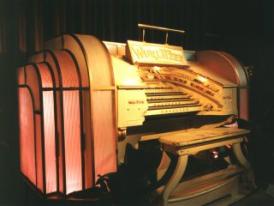 | ||
Gistok Member Username: Gistok Post Number: 5400 Registered: 08-2004 |
Andrew, this thread really belongs in Discuss Detroit (the thread title alone here will preclude most folks from reading it). Could you move it there and rename it to something like "C. Howard Crane - USA/Canada Theatres"? | ||
Aiw Member Username: Aiw Post Number: 6382 Registered: 10-2003 |
Good idea Gisok. I'll dig that article back out and put the whole thing up. | ||
Aiw Member Username: Aiw Post Number: 6383 Registered: 10-2003 |
Here's a few shots of Earl's Court. Very different to anything Crane Did here... Built in 1937. http://www.flickr.com/photo_zo om.gne?id=340623621&size=o http://www.flickr.com/photo_zo om.gne?id=223254091&size=l http://www.flickr.com/photo_zo om.gne?id=340638801&size=o | ||
Gistok Member Username: Gistok Post Number: 5401 Registered: 08-2004 |
Ok, let's sort out this puzzle.... From 1905-09 C. Howard Crane worked for Albert Kahn and Smith Hinchman Grylls (not sure the order or the exact dates). From 1909-14 he worked in Windsor with 2 Canadian architects. From 1909-10 with Canadian architect James Watt, and from 1910-14 with J.C. Pennington. In 1914 he went off on his own back to Detroit and had offices in the Dime Building. Then sometime in the late 1910's he moved his offices to the Huron Building (at the lastest he moved there by 1920). The Huron Building was being dismantled for the Guardian Building circa 1927, so Crane moved to the Michigan Building circa 1926 (when it opened) or 1927. Then circa 1930-31 Crane moved to London, England when his theatre commissions dried up in USA/Canada due to the depression. And he died in 1952 and is buried in London. | ||
Gistok Member Username: Gistok Post Number: 5402 Registered: 08-2004 |
56packman, interesting thing about the use of the name for movie theatres was "CINEMA" in Britain, France and Romance languages European countries. In the Germanic languages European countries they were called "KINO". | ||
56packman Member Username: 56packman Post Number: 1782 Registered: 12-2005 |
Ten years ago my wife and I (we were dating then) were in England and happened to get tickets to "the Royal tournament" at the Earl's court. It was a pageant of Britain’s military branches doing competitive field exercises like pulling a cannon from one end of the (huge, NFL-sized) field to the other end, disassembling it, putting it back together, pulling it as fast as they could to the opposite end of the field and firing it off (huge thrills!). The event began with the Royal Scottish guard band, the most perfect marching band I have ever seen or heard. They marched out from the staging area, playing, made a right angle turn and never during the time all of those hundreds of band members marched was there anything but a perfect right angle (I don't know much about what makes a marching band good, but this was obviously a big step up from what you see during a big 10 halftime show). They finished their number, stood at attention then the announcer boomed over the PA "all rise for her majesty the Queen” sure enough, a shoe-brown Rolls Royce drove out on to the field and a little old grey haired lady wearing a K-mart turquoise outfit got out of the car and did the royal wave, then went and sat in her box. The show morphed from a show of military excellence to a sort of WWE event later, I'm sure her majesty didn't stay for all that. I remember thinking that the Earls court reminded me of a huge version of Olympia, now I know why. | ||
Mikem Member Username: Mikem Post Number: 3481 Registered: 10-2003 |
quote: Still in the Dime in 1918. | ||
Carptrash Member Username: Carptrash Post Number: 1456 Registered: 10-2003 |
No mention of an office, but Michael Perkins book "LeVeque" shows a survey Crane filled out for the Michigan Society of Architects in which he admits to finishing two years of high school and advanced education at "the School of Hard Knocks." There's more. I just did a smash-and-grab at the LeVeque and the lobby, especially the elevator doors with bronze Signs of the Zodiac are pretty amazing. eeeeeeek | ||
Carptrash Member Username: Carptrash Post Number: 1457 Registered: 10-2003 |
Here is one quickie. eeeek 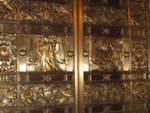 | ||
Gistok Member Username: Gistok Post Number: 5410 Registered: 08-2004 |
C. Howard Crane's Leveque Tower in Columbus, which ironically is about as tall as the Penobscot Building, but has a verticality that the Penobscot lacks: http://columbusretrometro.type pad.com/photos/downtown/dscn09 57.html Of course, being so slender, the tower has less than half the office space that the Penobscot has. Carptrash, although Corrado Parducci didn't do this work (not to my knowledge), it shows that Crane was no slouch when it came to human forms on the Leveque Tower: http://www.pictureninja.com/pa ges/united-states/ohio/image-l eveque-tower.htm | ||
Carptrash Member Username: Carptrash Post Number: 1458 Registered: 10-2003 |
No, even Crane's buldings in Detroit are not Parducci's. We (some self-promotion here - http://www.archsculptbooks.com /home.htm) think the sculpture was done by Maxfield and/or Charles Keck and made in Chicago at the Northwestern Terra Cotta Company. (Message edited by carptrash on September 26, 2007) | ||
Gistok Member Username: Gistok Post Number: 5415 Registered: 08-2004 |
Thanks for link Carptrash. I knew all of Crane's Detroit building embellishments were mainly Terra Cotta. Ironically my favorite decorative (non-figural) Parducci work is the wonderful plaster ceiling of the Christopher Wren inspired dining room of Meadowbrook Hall. My all time favorite USA sculptor happens to be Augustus St. Gaudens, who not only created works of brilliant classic beauty, but also created the 2 most beautiful American coins of all time... the $10 Indian Head gold piece (of 1907-33) and especially the $20 Flowing Liberty $20 gold piece (also of 1907-33). Unfortunately the new Eagle gold coins of the same design don't quite capture the beauty of the early 20th century originals. | ||
Gistok Member Username: Gistok Post Number: 5418 Registered: 08-2004 |
After C. Howard Crane's twin Fox masterpieces in Detroit and St. Louis, his largest theatre commission was the 4,088 seat Brooklyn Fox (1928), which is no longer standing. It appears to be in a Mexican Baroque style somewhat similar to Thomas Lamb's Loew's Ohio in Columbus, but on a larger scale: 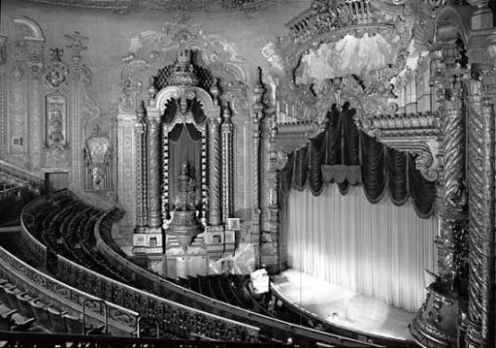 And as already mentioned, in Boston he helped C.A. Blackall with the design of the Wang Center (Metropolitan) Theatre (1925), which appears to have been smaller (3,700 seats) than I originally mentioned, but still making it the largest theatre in New England: 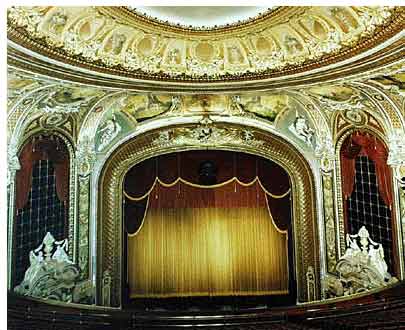 Notice how the auditorium of the Wang Center (from the stage) looks somewhat similar (but not in ornamentation) to the Detroit Fox: 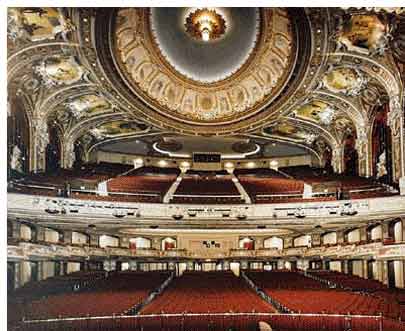 (Message edited by Gistok on September 27, 2007) | ||
Carptrash Member Username: Carptrash Post Number: 1459 Registered: 10-2003 |
If you get me talking about St. G I will end up being accused of hijacking the thread. But, yes, he's #1 in many hearts, including mine. (Message edited by carptrash on September 27, 2007) | ||
Fho Member Username: Fho Post Number: 64 Registered: 11-2003 |
C. HOWARD CRANE IN HIS OWN WORDS Crane wrote an article for a 1925 issue of Architectural Forum. He talks about his approach to theater design and architecture in general. He said theater design is like any other project in that you have a set of requirements and a program that have to be fulfilled. He says the biggest difference is the fire, safety and evacuation codes that theaters require. (Though a fraction of today's requirements). He also speaks to the charm of finding some hidden niches, seating areas, and details in all the little twists and turns in a theater. The article includes a few photos and cross-sections of the State & Capitol (Opera House). I made a photo-copy years ago and have been trying to scan it to upload but have been having difficulties. If anyone is interested I can pursue it further. Or you can find it in Lawrence Tech's library. | ||
Aiw Member Username: Aiw Post Number: 6388 Registered: 10-2003 |
Fho - I would love to see it. If you could scan it and email it to me, I would be happy to post it for you. andrew@internationalmetropolis .com | ||
Aiw Member Username: Aiw Post Number: 6389 Registered: 10-2003 |
Krawl/Gistok and anyone else interested... Here is the Crane article from the Windsor Star I was talking about. http://internationalmetropolis .com/19371230-ws-crane.pdf | ||
Jjaba Member Username: Jjaba Post Number: 5556 Registered: 11-2003 |
Thanks AIW. jjaba on the Westside. | ||
Fho Member Username: Fho Post Number: 65 Registered: 11-2003 |
Here is Crane's Architectural Forum article from 1925 mentioned above. It's in a zipped file containing four pages, about 2.17 meg. http://download.yousendit.com/ ACE80D24624FB806 | ||
Patrick Member Username: Patrick Post Number: 4991 Registered: 10-2003 |
A while back I started a thread on Crane's residential works and got a good number of responses. Can't find the thread though, but it was informative. He created 1630 Wellesley Drive for theater magnate John Kunsky. Might be the most detailed home in Palmer Woods. I also did the the former Jack White home in Indian Village http://en.wikipedia.org/wiki/J ohn_H._Kunsky | ||
56packman Member Username: 56packman Post Number: 1802 Registered: 12-2005 |
Fho--I downloaded the AF article by Crane on theatre design. There is a photo on the first page entitled "orchestra (main floor) of the playhouse, Detroit" and another photo showing a musician's gallery for the same building. I don't know anything about this facility. It is not the Player's theatre on Jefferson, that looks very different inside. This theatre pictured looks like the Harris or Selwyn in Chicago. Any clues? | ||
Gistok Member Username: Gistok Post Number: 5442 Registered: 08-2004 |
I just updated Wikipedia on John Kunsky. The old Fisher had 2,975 seats (not over 3,500), the Capitol had 3,384 seats (not 4,250), and the State originally had 2,967 (not the 2,200 it currently has with cabaret seating) and opened in 1925. Was the Majestic (1,585 seats) a Kunsky theatre? It wasn't listed under Kunsky. | ||
Fho Member Username: Fho Post Number: 66 Registered: 11-2003 |
I've been wondering where the Playhouse was for years. Perhaps the caption was wrong and it's actually not in Detroit. One of the cross-sections is from a theater in Ohio, so it's not all Detroit related. |